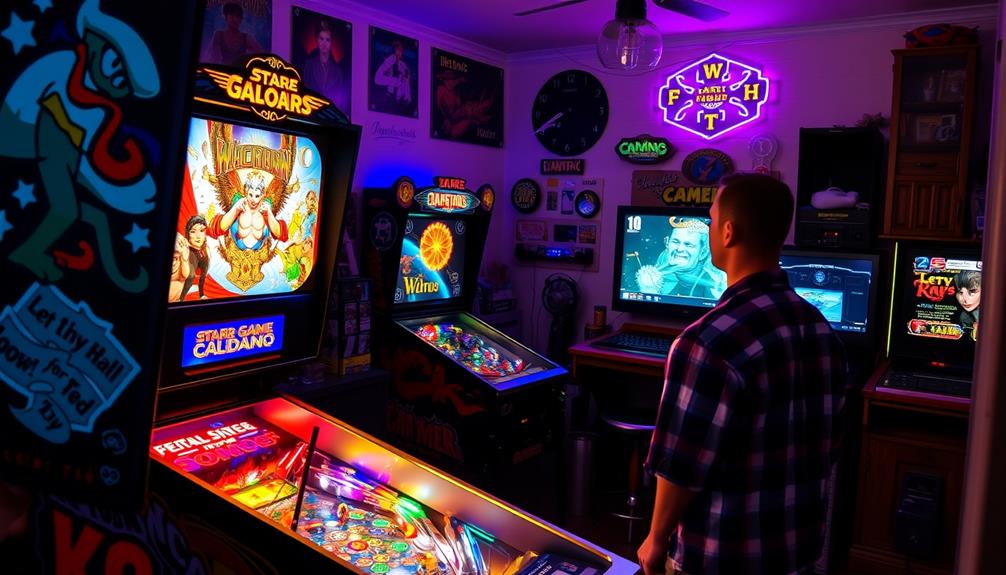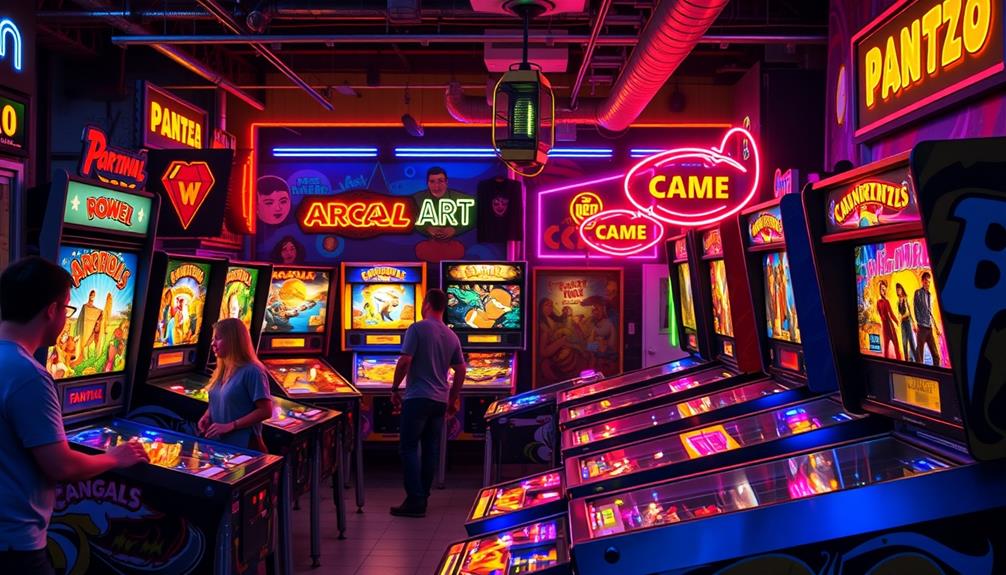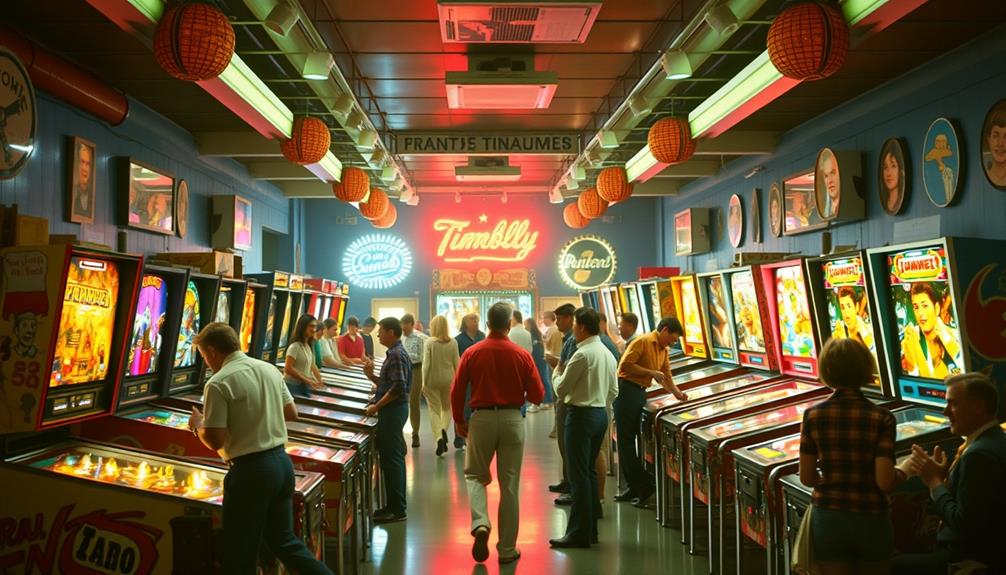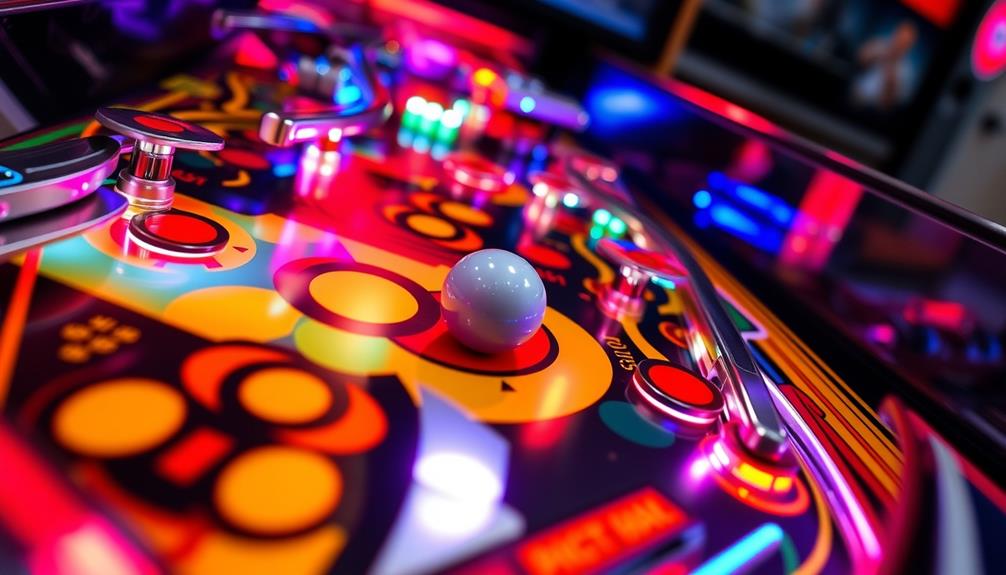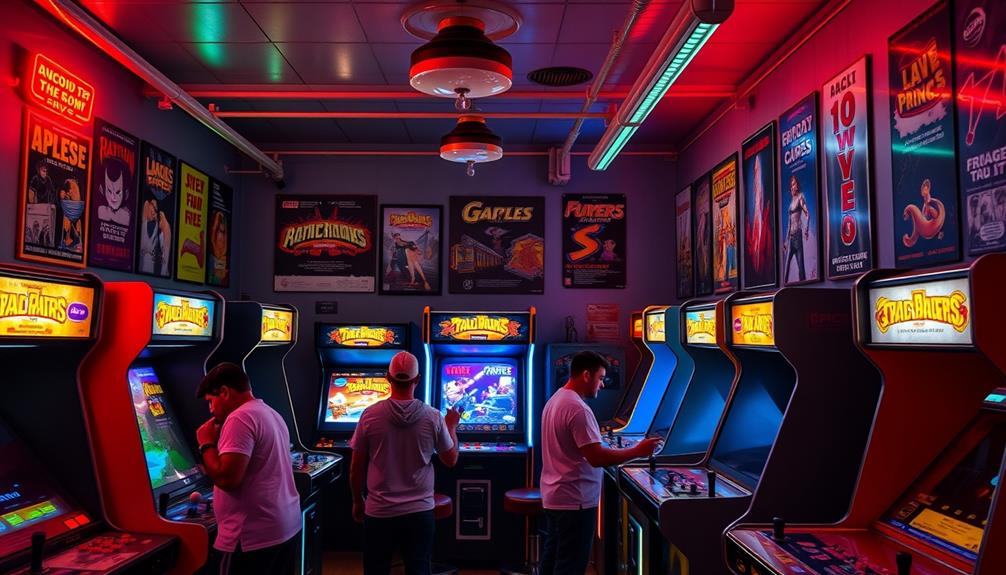Pinball machines have been around since the late 18th century, originating from the invention of Bagatelle. However, it wasn’t until the 1930s that the modern pinball machine really took off. The introduction of the first coin-operated version, Baffle Ball, in 1931 was a significant moment. By the mid-1930s, machines like Ballyhoo were gaining popularity, making pinball more accessible to everyone. Flippers revolutionized the game in 1947, shifting the focus from luck to skill. Since then, pinball has undergone significant evolution, becoming a beloved part of gaming culture. If you’re interested in learning more about the development of pinball over the years, there’s a lot more to discover.
Key Takeaways
- The origins of pinball machines trace back to the late 18th century with the game Bagatelle.
- The first modern coin-operated pinball machine, Baffle Ball, was introduced in 1931.
- Automatic Industries launched the first coin-operated model, the Whiffle Board, in the early 1930s.
- The term "pinball" became commonly used in 1936 as the game evolved.
- The introduction of flippers in 1947 marked a significant transition to skill-based gameplay.
Origins of Pinball Machines
Pinball machines' history begins with the late 18th century game Bagatelle, where players used a cue stick to shoot balls into scoring pockets. This early game set the stage for future developments.
In 1871, Montague Redgrave patented an improved version of Bagatelle, introducing a coiled spring and plunger mechanism that transformed gameplay. This innovation laid the groundwork for what would become the first modern pinball machines. Furthermore, the cultural impact of games like pinball has been significant, often intertwined with social gatherings and entertainment trends, similar to how astrology influences self-image.
By the early 1930s, Automatic Industries created the "Whiffle Board," one of the first coin-operated models. This marked a pivotal shift in pinball's evolution.
In 1934, Ballyhoo, introduced by Raymond Maloney, further popularized the game, making it accessible to a wider audience. Remarkably, this was one of the first machines to operate on a coin system, solidifying pinball's place in entertainment.
The term "pinball" emerged in 1936, distinguishing the game from its predecessors. Initially a game of chance, pinball evolved with skill-based elements thanks to the introduction of flippers in 1947.
These advancements set the stage for the dynamic pinball machines we recognize today, showcasing the rich history of pinball machines and their journey through innovation. Pinball machine basics include a playing field with various obstacles and targets, flippers to control the movement of the ball, and a scoring system. Over time, these basic elements have been enhanced and refined to create more immersive and interactive gameplay experiences. Today, modern pinball machines incorporate digital displays, advanced sound effects, and even interactive features that respond to player input, making them a true marvel of technological innovation.
Key Technological Innovations
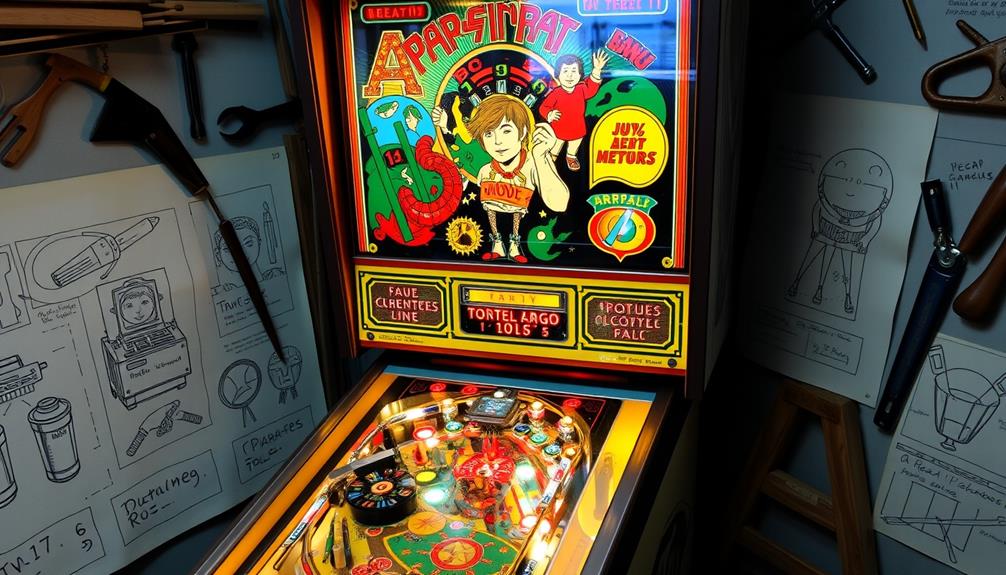
Throughout the evolution of pinball machines, key technological innovations have played a crucial role in shaping the gaming experience.
These advancements not only enhanced gameplay but also transformed how you interact with the machine. For instance, the development of various brewing methods in coffee reflects a parallel evolution in entertainment technology, showcasing how innovation can enhance user experience.
Here are some pivotal innovations:
- Baffle Ball: Introduced in 1931, it was the first modern coin-operated pinball machine, marking the industry's commercial launch.
- Electromechanical Sounds: In 1933, the first electrically powered pinball machine featured these sounds, providing auditory feedback that enriched the gameplay.
- Tilt Mechanism: Invented in 1935, this feature allowed you to manipulate the machine's position while preventing cheating by triggering penalties for excessive force.
- Player-Controlled Flippers: Introduced in 1947, this innovation shifted the focus from chance to skill, considerably increasing player engagement.
Evolution of Gameplay Mechanics

Evolving from simple mechanical interactions to intricate skill-based challenges, pinball gameplay mechanics have undergone considerable transformations since their inception. The first modern coin-operated pinball machine, Baffle Ball, introduced in 1931, marked the beginning of the pinball era, focusing primarily on mechanical gameplay. This laid the groundwork for future innovations and highlighted the importance of budgeting for entertainment expenses in a player's overall financial planning.
In 1947, the introduction of flippers with the game Humpty Dumpty revolutionized the experience, shifting pinball from a game of chance to one of skill and player control. The tilt mechanism, invented in 1935, added strategy by preventing cheating, further enhancing player engagement.
By the 1960s, gameplay mechanics became even more complex with the addition of multiball features, greatly increasing excitement and challenge.
The shift to solid-state technology in the mid-1970s brought about electronic scoring and enriched sound effects, transforming how you interact with the game.
These developments enriched the overall gameplay experience, making pinball not just a game of luck but a test of skill, timing, and strategy, reflecting the evolution of gameplay mechanics throughout the pinball era.
Cultural Significance of Pinball

The cultural significance of pinball extends far beyond its flashing lights and mechanical sounds; it represents a vibrant social hub where players gather to test their skills and enjoy friendly competition.
Pinball became a cultural staple in candy stores, pool halls, and amusement arcades during its peak in the mid-20th century. With its rich history, pinball also reflects the evolution of gaming and personal connections, much like the way celebrating love and legacy honors cherished memories.
Here are some key aspects of its cultural impact:
- Flippers Revolution: The introduction of flippers in 1947 transformed pinball from a game of chance to a skill-based activity, boosting its appeal.
- Nostalgic Collectors: Iconic machines have become valuable collectibles, fostering a sense of nostalgia for vintage gaming.
- Community Engagement: Competitive pinball tournaments and leagues promote social interaction, drawing players together in a shared passion.
- Arcade Entertainment Icon: Pinball's appearances in films, TV shows, and music solidify its status as a symbol of retro gaming culture.
Through these elements, pinball not only entertains but also strengthens community ties, making it a beloved fixture in the landscape of arcade entertainment.
Future Trends in Pinball Industry
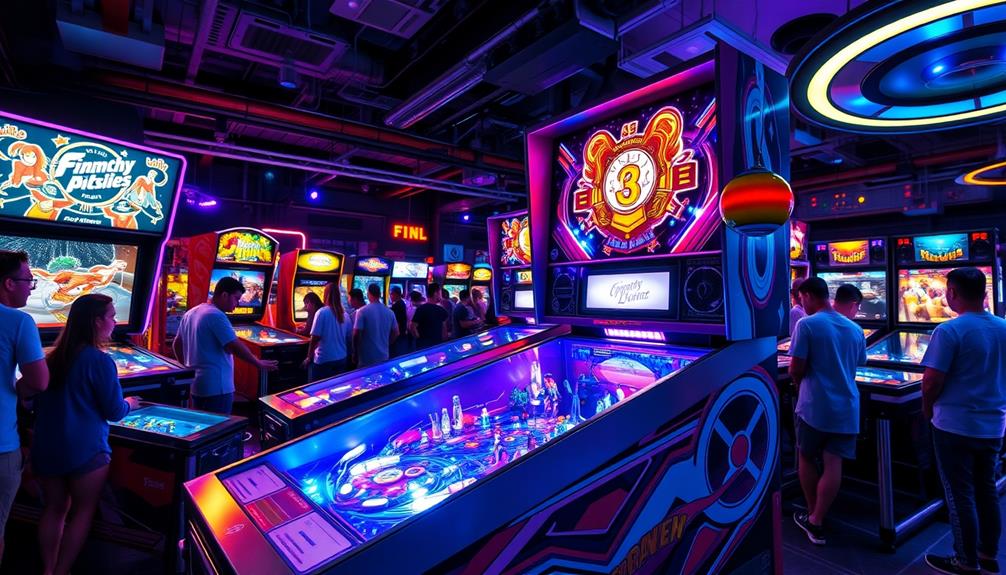
Pinball's rich cultural legacy sets the stage for exciting advancements in the industry. As you explore the future of pinball, you'll notice the rise of modern pinball machines that integrate cutting-edge technology. Independent manufacturers like Spooky Pinball and Heighway Pinball are driving innovation, enhancing the diversity of the market with unique designs and themes.
This evolution reflects a broader trend of fostering creativity and collaboration in various industries, akin to the principles of design thinking that emphasize user-centric solutions.
The integration of LCD screens and interactive elements in these machines is becoming increasingly popular. This technology not only captivates players but also creates immersive gameplay experiences that keep them coming back for more.
The resurgence of retro gaming culture has ignited a renewed interest in pinball, leading to a spike in arcade openings and increased sales of both commercial and home pinball machines. In fact, the ratio of home to commercial machines has surged to between 35%-60% in just a few years.
As the industry evolves, you can expect to see further advancements that cater to a broader audience. With the combination of nostalgia and modern innovation, the future of pinball looks bright, promising exciting developments for enthusiasts and new players alike.
Frequently Asked Questions
Why Were Pinball Machines Banned in the 1970S?
Pinball machines were banned in the 1970s mainly because people viewed them as gambling devices. Concerns about youth addiction and organized crime connections led to strict regulations, prompting cities to confiscate and destroy many machines.
When Did Pinball Machines Become Popular?
In the 1930s, pinball machines saw a surge in popularity, especially with games like Baffle Ball. By the late 1990s, The Addams Family became iconic, with over 20,000 units sold, enchanting players everywhere.
Was Pinball Popular in the 70S?
Yes, pinball was incredibly popular in the 70s. You'd find machines in arcades and bars everywhere, thanks to innovations like solid-state technology that made gameplay more exciting and competitive, enchanting players like you.
Were Pinball Machines Popular in the 80S?
You wouldn't believe the excitement! In the 80s, pinball machines exploded in popularity, enchanting players with advanced technology and thrilling gameplay. Iconic titles emerged, drawing crowds to arcades and bars, making pinball a cultural phenomenon.
Conclusion
To sum up, pinball machines have evolved remarkably since their origins, much like a river carving its path through rock. From early wooden models to today's high-tech marvels, each era has shaped the game and its cultural impact. As you immerse yourself in the world of pinball, you'll discover not just a game, but a vibrant community and a rich history. Keep an eye on future trends, as this classic pastime continues to surprise and delight enthusiasts everywhere.


